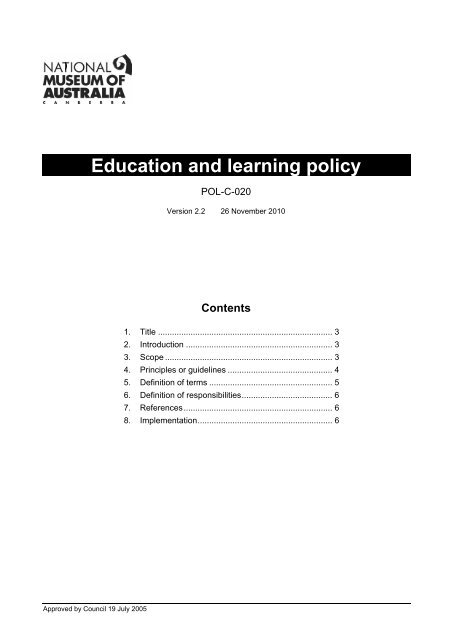Education and learning policy - National Museum of Australia
Education and learning policy - National Museum of Australia
Education and learning policy - National Museum of Australia
You also want an ePaper? Increase the reach of your titles
YUMPU automatically turns print PDFs into web optimized ePapers that Google loves.
)<strong>Education</strong> <strong>and</strong> <strong>learning</strong> <strong>policy</strong>POL-C-020Version 2.2 26 November 2010Contents1. Title ........................................................................... 32. Introduction ............................................................... 33. Scope ........................................................................ 34. Principles or guidelines ............................................. 45. Definition <strong>of</strong> terms ..................................................... 56. Definition <strong>of</strong> responsibilities....................................... 67. References................................................................ 68. Implementation.......................................................... 6Approved by Council 19 July 2005
<strong>Education</strong> <strong>and</strong> <strong>learning</strong> <strong>policy</strong> version 2.2 2/6IDVersion 2.2POL-C-020Version date 20 January 2010TypeCouncil approvedApproval date 18 March 2010FileAvailabilityKeywordsResponsible <strong>of</strong>ficerPublic <strong>and</strong> all staff<strong>Education</strong>, <strong>learning</strong>, continuous <strong>learning</strong>, lifelong <strong>learning</strong>, inquiry <strong>learning</strong>, multipleintelligences, outreach, pr<strong>of</strong>essional developmentAssistant Director, Audience, Programs <strong>and</strong> PartnershipsHistoryThis <strong>policy</strong> supersedes:<strong>Education</strong> <strong>policy</strong> approved by Council 28 July 2005<strong>Education</strong> <strong>and</strong> <strong>learning</strong> <strong>policy</strong> version 2.0, August 2008<strong>Education</strong> <strong>and</strong> <strong>learning</strong> <strong>policy</strong> version 2.1, 25 May 2009Review date August 2012Related documentsContact<strong>National</strong> <strong>Museum</strong> <strong>of</strong> <strong>Australia</strong>GPO Box 1901CANBERRA ACT 2601Tel: (02) 6208 5000Email: information@nma.gov.auWebsite: www.nma.gov.auApproved by Council 19 July 2005
<strong>Education</strong> <strong>and</strong> <strong>learning</strong> <strong>policy</strong> version 2.2 3/61. Title<strong>Education</strong> <strong>and</strong> <strong>learning</strong> <strong>policy</strong>2. IntroductionThe <strong>National</strong> <strong>Museum</strong> <strong>of</strong> <strong>Australia</strong> (the <strong>Museum</strong>) is a major cultural institution charged withresearching, collecting, preserving <strong>and</strong> exhibiting historical material <strong>of</strong> the <strong>Australia</strong>n nation.The <strong>Museum</strong> focuses on the three interrelated areas <strong>of</strong> Aboriginal <strong>and</strong> Torres Strait Isl<strong>and</strong>erhistories <strong>and</strong> cultures, <strong>Australia</strong>’s history <strong>and</strong> society since European settlement in 1788 <strong>and</strong>the interaction <strong>of</strong> people with the environment.Established in 1980, the <strong>Museum</strong> is a publicly funded institution governed as a statutoryauthority in the Arts portfolio. The <strong>Museum</strong>’s building on Acton Peninsula, Canberra openedin March 2001.3. ScopeFormal <strong>and</strong> informal activities based on education <strong>and</strong> a commitment to continuous <strong>learning</strong>are delivered at Acton, around <strong>Australia</strong> <strong>and</strong> occasionally internationally.<strong>Education</strong> <strong>and</strong> <strong>learning</strong> based activities include programs at Acton based on exhibitions <strong>and</strong>collections for visiting school groups, adults, young people <strong>and</strong> families; teacher <strong>and</strong> preserviceteacher pr<strong>of</strong>essional development activities; education resources in print <strong>and</strong>electronic formats, outreach programs <strong>and</strong> activities for school <strong>and</strong> community groups usingthe website <strong>and</strong> other communication methods. They may also include internationalpartnerships from time to time.<strong>Education</strong> <strong>and</strong> <strong>learning</strong> based activities focus on Aboriginal <strong>and</strong> Torres Strait Isl<strong>and</strong>erhistories <strong>and</strong> cultures, <strong>Australia</strong>’s history <strong>and</strong> society since European settlement in 1788 <strong>and</strong>the interaction <strong>of</strong> people with the environment. These activities relate primarily to the<strong>Museum</strong>’s collections <strong>and</strong> permanent <strong>and</strong> temporary exhibitions. Increasingly, they alsorelate to content created for the <strong>Museum</strong>’s website.3.1 BackgroundSince the Acton facility opened in 2001, the number <strong>of</strong> visiting school groups using education<strong>and</strong> <strong>learning</strong> programs has steadily increased each year with the majority <strong>of</strong> schools comingfrom New South Wales, <strong>Australia</strong>n Capital Territory, Victoria <strong>and</strong> Queensl<strong>and</strong>.In 2008, a new approach to public programs was developed to better reflect the <strong>Museum</strong>’spriorities <strong>of</strong> research <strong>and</strong> collections. Learning is at the heart <strong>of</strong> this approach - audienceresearch shows that it is the primary reason people visit the <strong>Museum</strong>. Public programs foradult audiences (symposia, lectures, workshops, public conversations <strong>and</strong> tours) <strong>and</strong>programs for families with children (delivered in school holidays), apply best-practiceconcepts <strong>of</strong> <strong>learning</strong>. Evaluation has shown that audiences are responding positively to thisnew strategy.3.2 DescriptionThis <strong>policy</strong> establishes principles to guide the <strong>Museum</strong>’s approach to education <strong>and</strong> <strong>learning</strong>.3.3 PurposeThis <strong>policy</strong> provides a framework within which the <strong>Museum</strong>:• promotes continuous <strong>learning</strong> as an organisation-wide principle• strives to provide lifelong education <strong>and</strong> <strong>learning</strong> opportunities for local, national, <strong>and</strong>international audiences• engages with communities through education <strong>and</strong> <strong>learning</strong> activitiesApproved by Council 19 July 2005
<strong>Education</strong> <strong>and</strong> <strong>learning</strong> <strong>policy</strong> version 2.2 4/6• maintains a sound working knowledge <strong>of</strong> school curricula <strong>and</strong> other educationframeworks <strong>and</strong> policies which relate to the <strong>Museum</strong>’s collections, exhibitions <strong>and</strong> webcontent• establishes partnerships with local, national <strong>and</strong> international education providers,including cultural institutions, education authorities, tertiary institutions <strong>and</strong> others• keeps abreast <strong>of</strong> national <strong>and</strong> international education <strong>and</strong> <strong>learning</strong> theories, trends <strong>and</strong>strategies• uses technology in innovative <strong>and</strong> creative ways, including internet, <strong>and</strong> videoconferencingto reach national <strong>and</strong> international audiences.3.4 RationaleThe <strong>Museum</strong>’s Act requires that the <strong>Museum</strong> disseminates ‘information relating to <strong>Australia</strong>nhistory <strong>and</strong> information relating to the <strong>Museum</strong> <strong>and</strong> its functions’. An effective education <strong>and</strong><strong>learning</strong> <strong>policy</strong> is essential to the <strong>Museum</strong>’s strategic objectives in particular, ‘Enhancenational <strong>and</strong> international pr<strong>of</strong>ile’, as described in the <strong>Museum</strong>’s Strategic Plan 2007–2010.4. Principles or guidelines4.1 Continuous (or lifelong) <strong>learning</strong>The <strong>Museum</strong> aims to provide formal <strong>and</strong> informal education <strong>and</strong> <strong>learning</strong> opportunities tosupport continuous or lifelong <strong>learning</strong> <strong>and</strong> acknowledges that <strong>learning</strong> occurs at all stages <strong>of</strong>life.4.2 Diversity <strong>of</strong> <strong>learning</strong> stylesThe <strong>Museum</strong> acknowledges that children <strong>and</strong> adults learn in different ways <strong>and</strong> strives to usea wide range <strong>of</strong> <strong>learning</strong> styles including visual/spatial, bodily/kinesthetic <strong>and</strong> verbal/linguisticstyles. Interpretative strategies <strong>and</strong> formats are varied to cater for this diversity <strong>and</strong> includeh<strong>and</strong>s-on <strong>and</strong> active <strong>learning</strong>, especially in relation to object or artifact interrogation,performance <strong>and</strong> role-play, <strong>and</strong> print.The <strong>Museum</strong> strives to allow children to make decisions in relation to their <strong>learning</strong>,sometimes referred to as ‘free choice <strong>learning</strong>’, but within a structured format with specified<strong>learning</strong> outcomes.The <strong>Museum</strong> supports intergenerational <strong>learning</strong> <strong>and</strong> actively encourages interactionbetween parents, gr<strong>and</strong>parents, carers <strong>and</strong> children <strong>and</strong> young people.4.3 Inquiry <strong>learning</strong>The <strong>Museum</strong> supports <strong>and</strong> promotes inquiry <strong>learning</strong> which encourages audiences,particularly school students, to reach their own conclusions about the subject matter beinginvestigated, based on sound research <strong>and</strong> evidence. This educational process empowersstudents to express well-informed views.4.4 Aboriginal <strong>and</strong> Torres Strait Isl<strong>and</strong>er educationThe <strong>Museum</strong> sees the development <strong>and</strong> dissemination <strong>of</strong> programs <strong>and</strong> curriculumresources related to <strong>Australia</strong>’s Aboriginal <strong>and</strong> Torres Strait Isl<strong>and</strong>er people as one <strong>of</strong> its keyeducation <strong>and</strong> <strong>learning</strong> priorities. In doing so the <strong>Museum</strong> will be cognizant <strong>of</strong> commonwealth<strong>and</strong> state <strong>and</strong> territory education department initiatives, <strong>and</strong> where possible, align itsactivities to support these.The <strong>Museum</strong> is also committed to providing opportunities for audiences, including Aboriginal<strong>and</strong> Torres Strait Isl<strong>and</strong>er people, to learn about <strong>and</strong> engage with Aboriginal <strong>and</strong> TorresStrait Isl<strong>and</strong>er cultures, histories <strong>and</strong> contemporary issues. The <strong>Museum</strong> consults withAboriginal <strong>and</strong> Torres Strait Isl<strong>and</strong>er communities <strong>and</strong> education providers in thedevelopment <strong>of</strong> Indigenous programs <strong>and</strong> projects.Approved by Council 19 July 2005
















